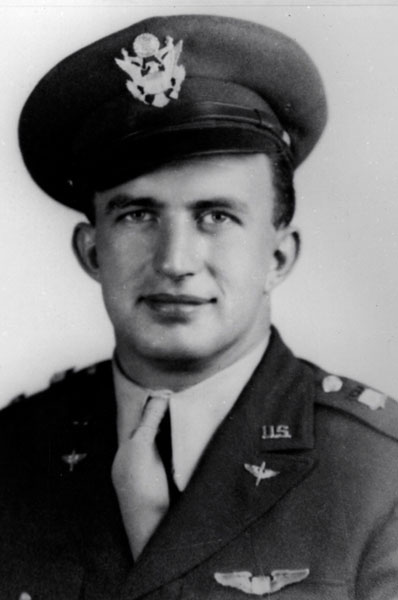 |
Captain Leland Francis Norton
Captain Norton stayed at the controls of his A-20 aircraft until his crew had all safely bailed out, but by then it was too late for him. For his heroic actions, Captain Norton was awarded the Distinguished Flying Cross (DFC), the highest Air Force Award. |
| Download HiRes |
The former Norton Air Force Base, located two miles east of downtown San Bernardino, CA, got its start in 1941 as a municipal airport under U.S. Army jurisdiction. Pilots trained there and, almost immediately after the attack on Pearl Harbor, fighter planes were stationed there in case they might be needed to protect the Los Angeles area from enemy attack.
In 1942, its name was changed to the San Bernardino Army Airfield. The San Bernardino Air Depot was established there for repair and maintenance of aircraft. Later it would be used to repair gas turbine engines and, later still, jet engines. At the end of World War II, the base became a processing and separation center for millions of servicemen being discharged.
In 1948, the facility was transferred to the newly-created Air Force as the San Bernardino Air Force Base. Two years later, the base was renamed for a San Bernardino native and World War II hero: Captain Leland Francis Norton. Twenty-three-year-old Capt. Norton died on his 16th combat mission over occupied France. Struck by enemy fire, he courageously remained with his A-20 Havoc until his crew of three had bailed out. By then, it was too late to save himself. The highest Air Force Award, the Distinguished Flying Cross, was awarded to Norton posthumously. The base was known as Norton Air Force Base until its closure in 1994.
In 1954, the main runway had to be extended to 10,000 feet to accommodate the largest Strategic Air Command (SAC) bombers, which were being sent to Norton for engine overhauls. Ballistic missile programs were assigned to SAC and the San Bernardino Air Depot provided logistical support for the Titan and Atlas Intercontinental Ballistic Missiles. A Southern California air defense system and data center, designed to protect the area in the event of Soviet nuclear attack, operated there from 1955-1966.
In the 1960s, the Peacekeeper and Minuteman programs were managed from Norton AFB. Norton facilities have been used as sets for many movies and TV productions over the decades. A Twilight Zone episode called "The Last Flight," in which a World War I Royal Flying Corps pilot is transported in time in a cloud to the 1960s, was shot at Norton. The episode, which first aired on February 5, 1960, featured a vintage fighter provided and flown by Hollywood stunt pilot Frank Tallman. "Closure," the 150th episode and the eleventh episode of the seventh season of the science fiction television series, "The X Files," was partially shot at San Bernardino International Airport. The episode first aired in the U.S. and Canada on February 3, 2000. SBIA was used as the filming location for the parts of the 2001 movie "The Fast and the Furious." Other movies with scenes shot there include: "Congo," "Executive Decision," "Desperate Measures," "Volcano," "Bad Boys I and II," "Terminator 3" and "The Aviator," which won five Oscars in 2005.
Other postwar developments included addition of the 63rd Military Airlift Wing in 1966, to supply airlift and food services to combat units around the world. Norton AFB was the final duty station of Sgt. John Levitow, the lowest ranking Airman to win the Medal of Honor, who served as a loadmaster with the 63rd Military Airlift Wing. Levitow received the award in 1970 for heroic actions which saved fellow crew members and the AC-47 gunship they were flying from death and destruction during a 1969 Vietnam night mission. Also in the 1960s, Norton became headquarters for the Aerospace Audiovisual Services, charged with producing training films for the Air Force. Norton AFB also housed the Air Force Inspection and Safety Center Headquarters, the Air Force Audit Agency Headquarters, Military Airlift Command Non-Commissioned Officer Academy-West, and Headquarters. Hubert H. Humphrey landed at Norton during the time he was serving as vice president of the United States, January 1965 until January 1969. A new passenger terminal opened in 1968, replacing a 1944 building, and was used by thousands of military personnel transported in and out of Vietnam. The C-141 Starlifter known as the Hanoi Taxi was based at Norton during this period. Famous passengers included entertainer Bob Hope, who rode the Taxi to Vietnam for USO shows, and Senator John McCain, who took the Taxi home in 1973 when he was released after five and a half years in POW camps. General Chuck Yeager, who made history in 1947 by flying faster than the speed of sound, served his last assignment at Norton AFB, retiring at the base in 1975. President Ronald Reagan landed at Norton on his way to the National Orange Show in San Bernardino in 1988. It was Reagan's third visit to the exhibition - he had traveled there previously as an actor in 1940 and as California's governor in 1968.
In 1988, the Base Realignment and Closure Commission (BRAC) announced closure of Norton Air Force Base. The base closed on March 31, 1994. Transfer of the whole base (2,221 acres) was completed by the Air Force Real Property Agency in June 2007, the non-aviation portion to the Inland Valley Development Agency and the airport to San Bernardino International Airport Authority, for redevelopment.